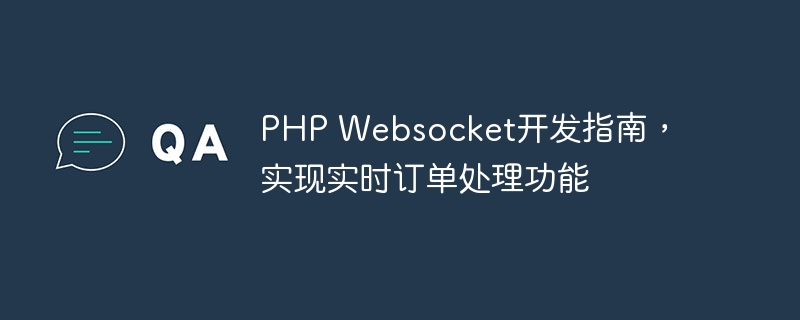

PHP Websocket Development Guide to Real-time Order Processing Function
Websocket is a protocol for real-time two-way communication between a web application and a server. Compared with traditional HTTP requests, WebSocket can establish persistent connections more efficiently to achieve real-time data transmission. In this article, I will introduce to you how to use PHP for Websocket development and implement a real-time order processing function.
First, we need to understand some basic concepts and principles. The WebSocket protocol uses a special HTTP handshake process to establish a persistent connection. After that, the client and server can perform two-way data transmission through this connection.
In PHP, you can use the Ratchet library to implement WebSocket functionality. Ratchet is an open source PHP Socket library that provides a set of easy-to-use APIs to facilitate us to quickly build WebSocket servers.
First, we need to install the Ratchet library. Ratchet can be easily installed through Composer. Open the command line window, enter the PHP project directory, and execute the following command:
composer require cboden/ratchet
After the installation is complete, we can start writing code. First, create a PHP file named server.php and introduce the Ratchet library into it:
<?php require 'vendor/autoload.php'; use RatchetMessageComponentInterface; use RatchetConnectionInterface; use RatchetServerIoServer; use RatchetHttpHttpServer; use RatchetWebSocketWsServer;
In the following code, we create a file named OrderHandler's class, which implements the MessageComponentInterface interface. This class will be responsible for handling messages sent by the client.
class OrderHandler implements MessageComponentInterface
{
protected $clients;
public function __construct()
{
$this->clients = new SplObjectStorage;
}
public function onOpen(ConnectionInterface $conn)
{
// 客户端连接成功时执行的代码
$this->clients->attach($conn);
}
public function onMessage(ConnectionInterface $from, $msg)
{
// 处理客户端发送的消息
// 在这里进行订单处理的逻辑
// 将处理结果发送给所有连接的客户端
foreach ($this->clients as $client) {
$client->send($msg);
}
}
public function onClose(ConnectionInterface $conn)
{
// 客户端断开连接时执行的代码
$this->clients->detach($conn);
}
public function onError(ConnectionInterface $conn, Exception $e)
{
// 发生错误时执行的代码
echo 'Error: ' . $e->getMessage() . PHP_EOL;
$conn->close();
}
}In the above code, through the onOpen method, we can execute the corresponding code when the client connection is successful. In the onMessage method, we can process the message sent by the client and implement the order processing logic here. Through the onClose method, we can execute the corresponding code when the client disconnects. onError method is used to handle errors that occur.
Finally, we need to create a WebSocket server and specify the port number. At the end of the server.php file, add the following code:
$server = IoServer::factory(
new HttpServer(
new WsServer(
new OrderHandler()
)
),
8080
);
$server->run(); In the above code, we created a WebSocket server through the IoServer class, specifying a HttpServer to handle HTTP requests, and a WsServer to handle the WebSocket protocol. The OrderHandler class is responsible for handling specific order logic. The server listens on port 8080.
Save and execute the server.php file, and the WebSocket server has been started. Next, we need to add the corresponding code on the client side to connect to the server.
<!DOCTYPE html>
<html>
<head>
<title>WebSocket Order</title>
<script src="https://code.jquery.com/jquery-3.6.0.min.js"></script>
<script>
$(function () {
var conn = new WebSocket('ws://localhost:8080');
conn.onopen = function (event) {
console.log('Connected');
};
conn.onmessage = function (event) {
var data = JSON.parse(event.data);
console.log('Received:', data);
// 在这里进行订单处理后的操作
};
conn.onclose = function (event) {
console.log('Disconnected');
};
});
</script>
</head>
<body>
</body>
</html>In the above code, we use the WebSocket object in JavaScript to establish a connection with the server. Through the corresponding event listening function, we can process the message sent by the server and perform post-order processing operations in the conn.onmessage function.
So far, we have completed a simple real-time order processing function. When a new order is generated, the server will send order information to all connected clients, and the clients can perform further processing.
Through the introduction of this article, we can see that it is very simple to use PHP and Ratchet library for WebSocket development. With WebSocket, we can achieve real-time two-way communication and bring more interactive experience to web applications. I hope this article will be helpful for everyone to understand and learn PHP WebSocket development and implement real-time order processing functions.
The above is the detailed content of PHP Websocket development guide to implement real-time order processing function. For more information, please follow other related articles on the PHP Chinese website!




